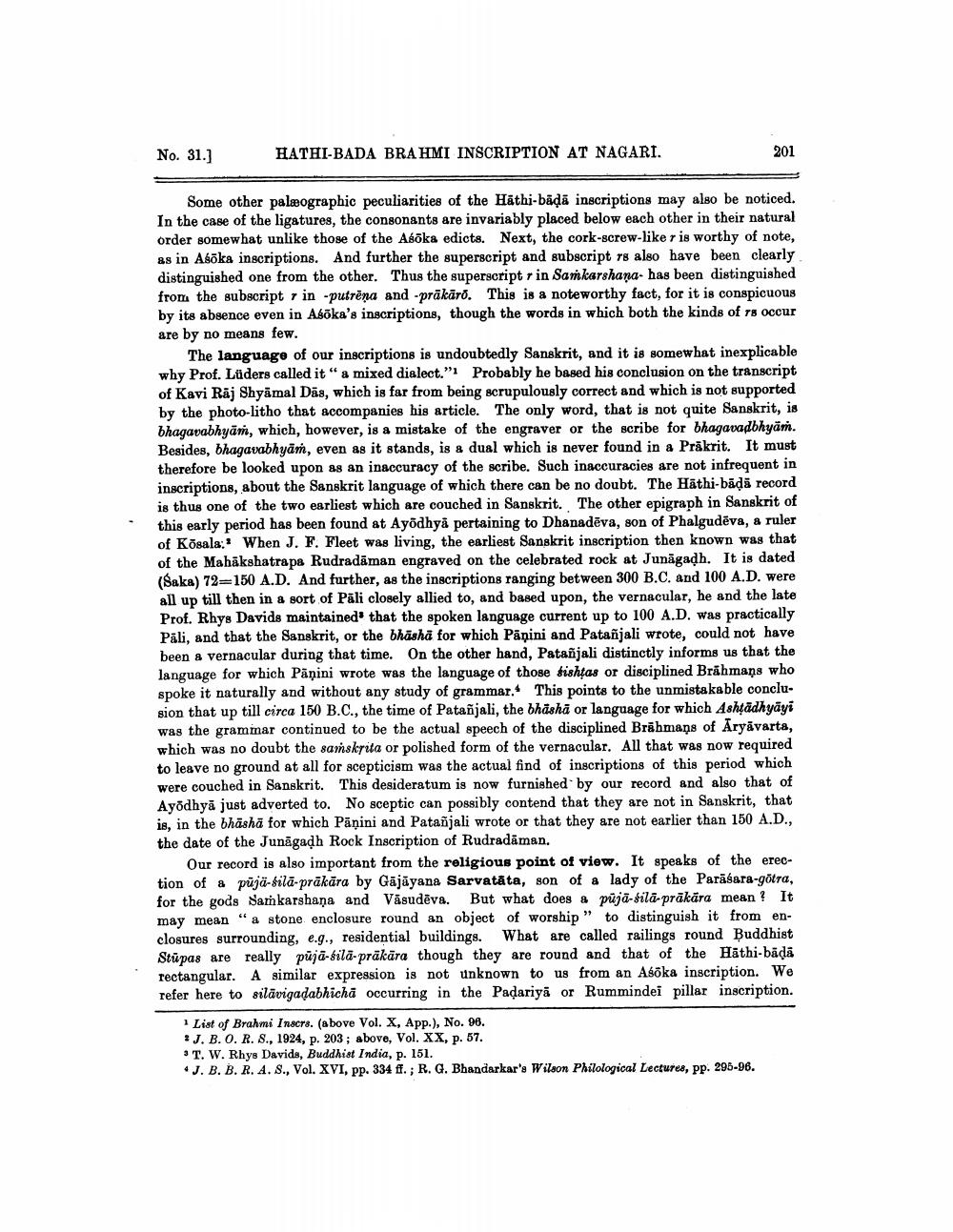________________
No. 31.)
HATHI-BADA BRAHMI INSCRIPTION AT NAGARI.
201
Some other palæographic peculiarities of the Hathi-bādā inscriptions may also be noticed. In the case of the ligatures, the consonants are invariably placed below each other in their natural order somewhat unlike those of the Asöka edicts. Next, the cork-screw-liker is worthy of note, as in Asöka inscriptions. And further the superscript and subscript is also have been clearly distinguished one from the other. Thus the superscript r in Sankarshana- has been distinguished from the subscript r in -putrēna and -prākāro. This is a noteworthy fact, for it is conspicuous by its absence even in Asöka's inscriptions, though the words in which both the kinds of 78 occur are by no means few.
The language of our inscriptions is undoubtedly Sanskrit, and it is somewhat inexplicable why Prof. Lüders called it" a mixed dialect."i Probably he based his conclusion on the transcript of Kavi Raj Shyamal Das, which is far from being scrupulously correct and which is not supported by the photo-litho that accompanies his article. The only word, that is not quite Sanskrit, is bhagavabhyām, which, however, is a mistake of the engraver or the scribe for bhagavadbhyām. Besides, bhagavabhyām, even as it stands, is & dual which is never found in a Prakrit. It must therefore be looked upon as an inaccuracy of the scribe. Such inaccuracies are not infrequent in inscriptions, about the Sanskrit language of which there can be no doubt. The Häthi-bădă record is thus one of the two earliest which are couched in Sanskrit. The other epigraph in Sanskrit of this early period has been found at Ayodhya pertaining to Dhanadēva, son of Phalgudēva, a ruler of Kõsala: When J. F. Fleet was living, the earliest Sanskrit inscription then known was that of the Mahākshatrapa Rudradāman engraved on the celebrated rock at Junagadh. It is dated (Saka) 72=150 A.D. And further, as the inscriptions ranging between 300 B.C. and 100 A.D. were all up till then in a sort of Pāli closely allied to, and based upon, the vernacular, he and the late Prof. Rhys Davids maintained that the spoken language current up to 100 A.D. was practically Päli, and that the Sanskrit, or the bhäsha for which Pänini and Patañjali wrote, could not have been a vernacular during that time. On the other hand, Patañjali distinctly informs us that the language for which Pāņini wrote was the language of those fishtas or disciplined Brāhmaṇs who spoke it naturally and without any study of grammar.* This points to the unmistakable conclusion that up till circa 150 B.C., the time of Patañjali, the bhäsha or language for which Ashtādhyāyi was the grammar continued to be the actual speech of the disciplined Brāhmaṇs of Aryāvarta, which was no doubt the saṁskrita or polished form of the vernacular. All that was now required to leave no ground at all for scepticism was the actual find of inscriptions of this period which were couched in Sanskrit. This desideratum is now furnished by our record and also that of Ayodhyā just adverted to. No sceptic can possibly contend that they are not in Sanskrit, that is, in the bhāsha for which Pāṇini and Patañjali wrote or that they are not earlier than 150 A.D., the date of the Junagadh Rock Inscription of Rudradaman,
Our record is also important from the religious point of view. It speaks of the erection of a pūjä-bilā-prākāra by Gājāyana Sarvatāta, son of a lady of the Parāśara-gotra, for the gods Sarkarshaņa and Väsudēva. But what does & pūjā-sila-prākāra mean! It may mean "a stone enclosure round an object of worship” to distinguish it from enclosures surrounding, e.g., residential buildings. What are called railings round Buddhist Stūpas are really pūjā-tilā-prākāra though they are round and that of the Häthi-bādā rectangular. A similar expression is not unknown to us from an Asoka inscription. We refer here to silāvigadabhicha occurring in the Padariya or Rummindei pillar inscription.
List of Brahmi Inscrs. (above Vol. X, App.), No. 96. : J. B.O. R. 8., 1924, p. 203; above, Vol. XX, p. 57.
T. W. Rhys Davids, Buddhist India, p. 151. .J.B.B. R. A. S., Vol. XVI, pp. 334 ff.; R. G. Bhandarkar's Wilson Philological Lectures, pp. 295-96.




